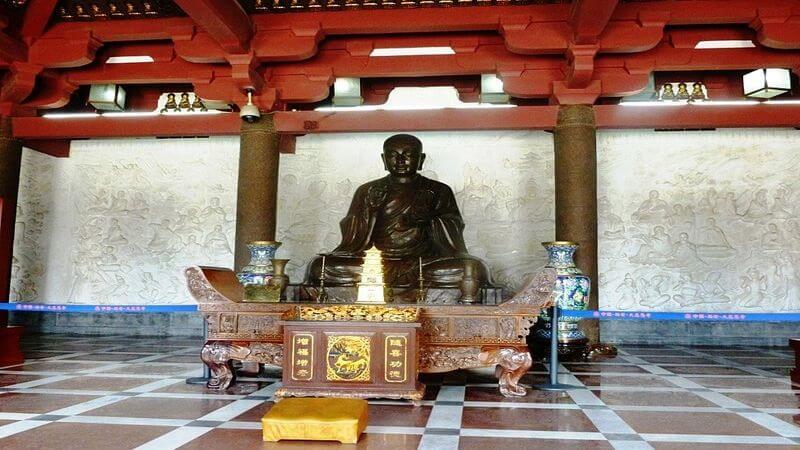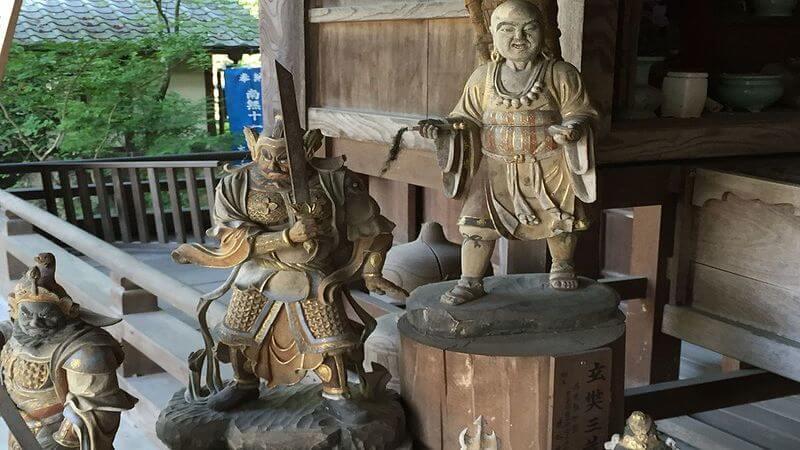The Famous Foreign Travelers Who Visited Ancient India
India has always been the dream destination for people who want to explore one of the earliest civilizations in the world. Since time immemorial, India has received several keen travelers who came here and fell in love with its traditions and colors. While the British travelers were actually the hidden form of imperialists, the earlier travelers came to India for the sake of attaining knowledge, learning, and customs. These travelers documented their experiences of the country and became the earliest chroniclers of history. In fact, most of what we know of ancient India today is through the accounts of these travelers. Here is the list of foreign travelers who visited India and explored its varied cultural terrain:
1. Hiuen Tsang from China (630-645 A.D.)
 PC: Wikipedia
PC: Wikipedia
One of the earliest and the most celebrated travelers to India, Hiuen Tsang came from China to India in search of Buddhist belief and practice. He has been described as the "prince of pilgrims” and his accounts carry a lot of information on the political, social and religious set up of India. Hiuen Tsang visited Kashmir, Punjab and proceeded to Kapilavastu, Bodh-Gaya, Sarnath, and Kusinagara. He studied at the University of Nalanda and traveled through the Deccan, Orissa, and Bengal. Since he stayed in India for 14 long years, his accounts reflect what ancient India must have been once.
2. Al Beruni from Persia (1024-1030 A.D.)
Al Beruni was an Islamic scholar who was "commissioned" by Mahmud of Ghazni to write his monumental commentary on Indian philosophy and culture Kitab fi tahqiq ma li'l-hind. In the words of the historians today, "His observations on Indian conditions, systems of knowledge, social norms, religion ... are probably the most incisive made by any visitor to India." Born in Uzbekistan, this traveler remained in India for thirteen long years to understand its culture and literature.
3. Ibn Batuta from Morocco (1333-1347 A.D.)
It is unbelievable that a person could have traveled so much in times where no traveling paraphernalia was available. Meet Ibn Battuta who had a passion for travel unparalleled in history, inimitable by any individual. It is hard to believe that Ibn Battuta journeyed more than 75,000 miles (121,000 km), a figure unsurpassed by any individual explorer until the coming of the Steam Age some 450 years later. He was the only medieval traveler who is known to have visited the lands of every Muslim ruler of his time. His journeys include trips to North Africa, West Africa, Southern Europe, and Eastern Europe in the West, Middle East, South Asia, Central Asia, Southeast Asia, and China in the East, a distance surpassing threefold his near-contemporary Marco Polo.
4. Marco Polo from Italy (b.1254-d.1324)
Marco Polo, the Venetian traveler, is perhaps the most celebrated traveler even till today. He is said to have visited South India twice, in 1288 and 1292, where he saw a tomb of St. Thomas "at a certain little town” which he does not name. Many historians accept these dates and visits without question and identify the little town that he speaks of with Mylapore.
5. Abdur Razzak from Persia (1443-1444 A.D.)
One of the earliest mentions of the Vijaynagar empire in India comes through Abdul Razzak, the Persian traveler who visited it around 1440. His accounts of the Hampi marketplace, its architecture and grandeur have left a lot of corpus of history for later historians to work on. Abdur Razzak was the ambassador of the Shahrukh of the Timurid Dynasty.
6. Megasthenes from Greece (302-298 B.C.)
Megasthenes was a Greek historian who came to India in the fourth century B.C. as an ambassador of Seleucus Nicator. He lived in the court of Chandragupta Maurya for about five years (302-298 B.C.). His experience of India is written in his book entitled "INDIKA”. Through his accounts, we come to know everything that he had seen in India- its geography, government, religion, and society.
Must Read: Oldest Languages in the World Still in Use
7. Fa Hien from China (405-411 A.D.)
 PC: Wikipedia
PC: Wikipedia
Fa-Hien was the first Chinese monk to travel to India in search of great Buddhist scriptures. At the age of sixty-five, he traveled, mostly on foot, from Central China taking the southern route through Shenshen, Dunhuang, Khotan, and then over the Himalayas, to Gandhara and Peshawar.
8. Nicolo Conti from Italy (1420-1421 A.D.)
Nicolo De Conti' (fl. 1419-1444) was a Venetian explorer and writer who visited the west coast of India to Ely and struck inland to Vijayanagar, the capital of the principal Hindu state of the Deccan. Of this city, Conti gives an elaborate description and one of the most interesting portions of his narrative. From Vijayanagar and the Tungabudhra he traveled to Maliapur near Madras, present-day Chennai
9. Afanasy Nikitin from Russia (1469-1472)
 PC: Wikipedia
PC: Wikipedia
Nikitin, the Russian merchant, spent more than two years in India traveling to different cities, getting acquainted with local residents and carefully describing everything he saw. The notes of the merchant were compiled in the form of a so-called "Journey," which is more like a traveler’s log. This work accurately described the nature and political organization of India as well as its traditions, lifestyle, and customs.
10. Domingo Paes from Portugal (1520-1522 A.D.)
After the conquest of Goa in 1510 and its rise as the capital of the Portuguese Estado da India, several Portuguese travelers and traders visited Vijayanagara and wrote detailed reports about the glory of Bisnaga of Vijayanagara. Most valuable is that of Domingos Paes written in c. 1520-22. The report of Paes, who visited Vijayanagara during Krishnadeva's reign, is based primarily on careful observation as he describes in detail the so-called feudal nayankara system of Vijayanagara's military organization and the annual royal Durga festival.
11. Fernao Nunes from Portugal (1535-1537 A.D.)
Fernao Nuniz, a Portuguese horse-trader, composed his account of India around 1536-37. He was in the capital of Vijaynagara, during the reign of Achyutaraya and may have been present at earlier battles fought by Krishnadevaraya. This visitor was particularly interested in the history of Vijayanagara, especially the foundation of the city, the subsequent careers of three dynasties of rulers, and the battles that they fought with the Deccan sultans and Orissan Rayas. His accounts also give an insight into the Mahanavami festival, where he notes admiringly the extravagant jewels worn by the courtly women, as well as the thousands of women in the king’s service.
Also Read: Lesser Known Facts of Hampi
12. Vasco De Gama (1497–99, 1502–03, 1524)
Vasco De Gama was the first Portuguese or in fact the first European to reach India. He is an important traveler to India whose history is closely intermeshed with that of Goa. After sailing down the western coast of Africa and rounding the Cape of Good Hope, his expedition made numerous stops in Africa before reaching the trading post of Calicut, India, in May 1498. For his second journey, Da Gama arrived in Goa with the task of combating the growing corruption that had tainted the Portuguese government in India.
The question arises as to whether we had any travelers in the past who left their domestic hearth and left to travel abroad? The answer would be very few. Even if they are, there accounts and narratives don’t add much to our travel corpus today. The reason was that India had not been much of a traveling nation like Persia, Britain, Italy and many more. Indians considered themselves to be a satisfied lot with their country and rarely went across the borders. However, with the growing trend of tourism, today Indians are making a lot of travel journeys and planning trips, thereby becoming the observers rather than the subjects of narratives. Let us travel, explore and know the world and write it down in our words forming our own travel diaries.
* This is a List of Important Foreign travelers or Envoys in Indian history which is very important for examinations like UPSC, State Services, SSC, etc. Please let us know if you want any corrections or any addition to this list in the comments below.
Frequently Asked Questions About Ancient travelers in India
-
Q. Who is the first Chinese Traveller to India?
A. Fa-Hien or Faxian (AD 399 – 413) was the first Chinese traveler to visit India. He was a monk and he traveled in search of great Buddhist scriptures.
-
Q. Who is the first Traveller to India?
A. Megasthenes, ambassador of Seleucus Nikator was the first foreign traveler to India. He visited India during the supremacy of Chandragupta Maurya.
-
Q. Who were the two Chinese travelers who visited India?
A. Two principal Chinese travelers who traveled to India lived here for many years and returned to China sharing their learnings were Faxian (often spelled in Indian history books as Fa-Hian
-
Q. Who was the Chinese traveler to visit India during the period of Chandragupta Maurya?
A. Fa-Hien or Faxian visited India during the reign of the Gupta emperor Chandragupta Maurya
-
Q. Which foreign Traveller has been called Prince of medieval Travellers?
A. Italian traveler Marco Polo (1254-1324) is called as Prince of medieval Travellers. He was a European traveler. He has recorded all his travel experiences in India, observations related to geography & economic history of India in the book named The Book of Ser Marco Polo, the Venetian.
-
Q. Which European Traveller had observed a Hindu woman can go anywhere alone?
A. Abbe J.A. Dubois (Jean-Antoine Dubois) commented, at the beginning of the 19th century, "a Hindu woman can go anywhere alone even in the most crowded places."

 PC:
PC:  PC:
PC: